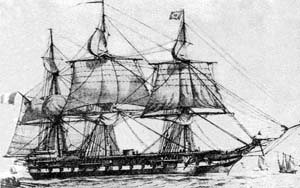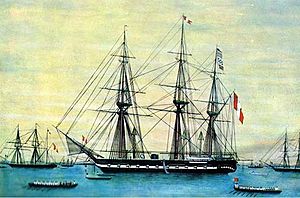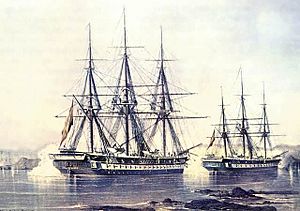Peruvian frigate Apurímac facts for kids
class="infobox " style="float: right; clear: right; width: 315px; border-spacing: 2px; text-align: left; font-size: 90%;"
| colspan="2" style="text-align: center; font-size: 90%; line-height: 1.5em;" | 
|} The BAP Apurímac was a special type of warship called a steam frigate. It was the second one of its kind in the Peruvian Navy. This ship was built in England in 1855. It was part of a big plan to make the Peruvian Navy stronger under President José Rufino Echenique.
The Apurímac was involved in two wars and many local conflicts. Because it got old, it became a training ship in Callao port from 1873. On January 17, 1881, it was sunk on purpose. This was done to stop Chilean troops from capturing it. The Chilean army had taken over the port after winning battles against the Peruvian Army.
Contents
- Peruvian Civil War (1856–1858)
- War with Ecuador (1857–1860)
- Raising and Repairing the Ship
- Chincha Islands War and the Battle of Abtao
- Later Years: War of the Pacific
| History | |
|---|---|
| Name | Apurímac |
| Ordered | August 1852 |
| Builder | Richard & Henry Green Shipyard, Blackwall (United Kingdom) |
| Laid down | 1853 |
| Launched | July 1854 |
| Commissioned | August 1855 |
| Renamed | Callao (1858-1863) |
| Fate | Scuttled to prevent capture in Callao harbor, January 16, 1881 |
| Notes | Served as training ship from 1873 |
| General characteristics | |
| Class and type | Screw-propelled steam frigate |
| Tons burthen | 1,666 tons bm |
| Length | 62.17 m (204 ft 0 in) |
| Beam | 13.10 m (43 ft 0 in) |
| Draft | 7.16 m (23 ft 6 in) |
| Propulsion |
|
| Sail plan | Frigate sail rigging |
| Speed |
|
| Complement | 200 |
| Armament |
|
Building the Apurímac
In 1852, Peru had one of the strongest navies in South America. They already had two steam warships. To make sure no European countries would interfere, Peru decided to order three more steam warships from England. These included two smaller ships called schooners, and the large steam frigate Apurímac.
The order for Apurímac was placed in August 1852. It was built at the Richard & Henry Green Shipyard in London. A Peruvian-Chilean captain named Jose Maria Salcedo watched over its building. The ship was officially ready for service in August 1855. It arrived at the port of Callao in Peru on November 12, 1855.
Ship's Adventures
Peruvian Civil War (1856–1858)
On November 16, 1856, the Apurímac was anchored in Arica. Two young officers, Lizardo Montero and Miguel Grau, took control of the ship. They supported a different leader, Manuel Ignacio de Vivanco. They took the chance when the ship's commander was visiting ashore. Their first act was to free political prisoners held on other ships in Arica.
Then, Apurímac sailed north and convinced another government ship, the schooner Loa, to join their side. President Ramon Castilla declared that these ships were pirate ships. He offered a big reward of 200,000 pesos to anyone who could capture Apurímac. The government sent more ships to stop them, but one of them, Tumbes, also joined the rebels.
On November 27, 1856, Apurímac and Tumbes visited Arica. On December 28, the rebel fleet captured the Chincha Islands. On December 31, 1856, Apurímac and the schooners Loa and Tumbes started a blockade of Callao. This meant they blocked the port to stop ships from entering or leaving. The port was defended by one government ship and an old fort.
The Apurímac tried to capture the government ship on January 28, but it was well defended. Finally, the Apurímac left the port on March 30 to get more supplies. It returned on April 30, 1857, carrying Vivanco and his army. They tried to capture the port by surprise, but it failed.
The Peruvian government then made a deal with Britain and France. Their ships would protect important guano production and their business interests. The reward for capturing Apurímac was raised to 500,000 pesos. President Castilla also offered to forgive the rebel sailors. Knowing they might be defeated by the strong French and British ships, the rebel officers decided to give up. The fleet sailed to Callao and was taken by the government. On April 28, 1858, President Castilla renamed the ship Callao. This was to honor the people who defended that province.
War with Ecuador (1857–1860)
The frigate, now called Callao, took part in the blockade of Guayaquil. It was the main ship, or flagship, of the Peruvian Navy. This blockade started on November 4, 1858. It lasted for a year until the port was captured in November 1860.
After this war, the frigate was put in a special floating dock. But on December 17, 1860, the ship and the dock sank. About 100 people died, and 88 were hurt.
Raising and Repairing the Ship
To get the ship back, Peru hired two brothers from Brooklyn, Renton and Addison Crosby. They were paid 100,000 pesos for the difficult job. The ship was almost raised on September 11, 1863. But they couldn't get all the water out, and it sank again.
After three years underwater, the ship was finally raised on April 16, 1863. It was pulled onto San Lorenzo Island. It was also renamed Apurímac again. The ship had big repairs between 1863 and 1864. They even added metal armor to its sides. But these changes made it slower and harder to steer. Even without its masts, the Apurímac took part in a bombing of Arica that same year.
Chincha Islands War and the Battle of Abtao
Soon after Peru declared war on Spain, the Apurímac was sent to Chile. It was still missing its masts. It went to join other ships, including a Chilean schooner, in the Chiloé Archipelago. They were waiting for two new Peruvian ships to arrive.
On January 15, 1866, another Peruvian ship, the Amazonas, got stuck and was lost. Its guns were moved to other ships or used as land defenses. The fleet gathered on February 4, 1866, at a naval base near Abtao Island. Apurímac became the main ship of the group. The Peruvian captain Manuel Villar was put in charge of all the allied ships.
On February 7, two Spanish ships appeared. Their goal was to destroy the allied fleet. The allied ships knew they were coming. Captain Villar ordered them to form a battle line. The Spanish ships slowly entered the cove. Apurímac started the battle by firing its guns from far away. The rest of the allied fleet followed.
The Spanish ships fired back. But the allied ships were very accurate. This forced the Spanish ships to hide behind Abtao island. They continued to fire from there. After two hours of fighting and many shots fired, the Spanish ships slowly left. Apurímac had some damage, with three hits to its side and minor damage on its main deck. The ship stayed in Chile until the war ended.
Later Years: War of the Pacific
After returning to Callao, the Apurímac had more repairs. It finally got its masts back. It served until 1873 when its engines and boilers stopped working. They were removed, and the frigate became a training vessel. In 1877, the armor added earlier was removed. This helped the ship become more stable again.
Apurímac continued as a training ship until the War of the Pacific began. During the first part of the war, it stayed in Callao harbor. It was just a hulk, meaning it couldn't move on its own. It avoided damage from the Chilean Navy's attacks on Callao between 1880 and 1881.
However, on the night of January 16, 1881, the Peruvian Army lost important battles. To stop the Chilean troops from capturing the remaining Peruvian ships, the Navy decided to destroy them. This order was carried out early on January 17, 1881. The Apurímac was sunk on purpose, or scuttled, to prevent it from falling into enemy hands.
See also
 In Spanish: Fragata Apurímac para niños
In Spanish: Fragata Apurímac para niños



